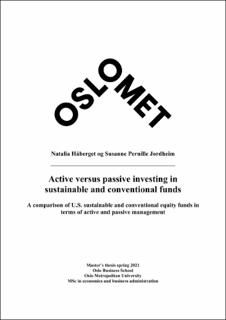Active versus passive investing in sustainable and conventional funds: A comparison of U.S. sustainable and conventional equity funds in terms of active and passive management
Master thesis
Submitted version
Permanent lenke
https://hdl.handle.net/11250/2823387Utgivelsesdato
2021Metadata
Vis full innførselSamlinger
Sammendrag
This thesis examines whether it is possible to create an excess return in equity funds by
following an active management strategy rather than a passive strategy. In addition, we
compare sustainable and conventional funds in relation to both management styles. To study
whether they create an excess return in relation to the market, we use the CAPM model and
multi-factor models that control for various risk factors. To expand our understanding of the
funds’ performance and behaviour, we analyse a sub-sample period that excludes the
recession period of 2020.
First, the regression results conclude that the majority of the funds underperform in relation to
the market. The significant alpha values are exclusively negative. The passive funds perform
better than their active counterparties, and the sustainable funds do better than the
conventional funds. Despite these results, the differences are not statistically significant, and
we can therefore not come to a clear conclusion. Second, when examining the sub-sample
period, we find that the funds still underperform in relation to the market, but there is a positive
change in the alpha values for all the funds. The findings imply that sustainable funds tend to
outperform their conventional fund peers during the crisis period. Hence conventional funds
are more sensitive and more exposed to market fluctuations during crises.
Our findings indicate that only a few American ETFs are skilled enough to generate abnormal
returns compared to the market. However, the majority generate negative alpha values during
both the entire time and sub-sample periods, suggesting that American markets are
somewhat efficient.
